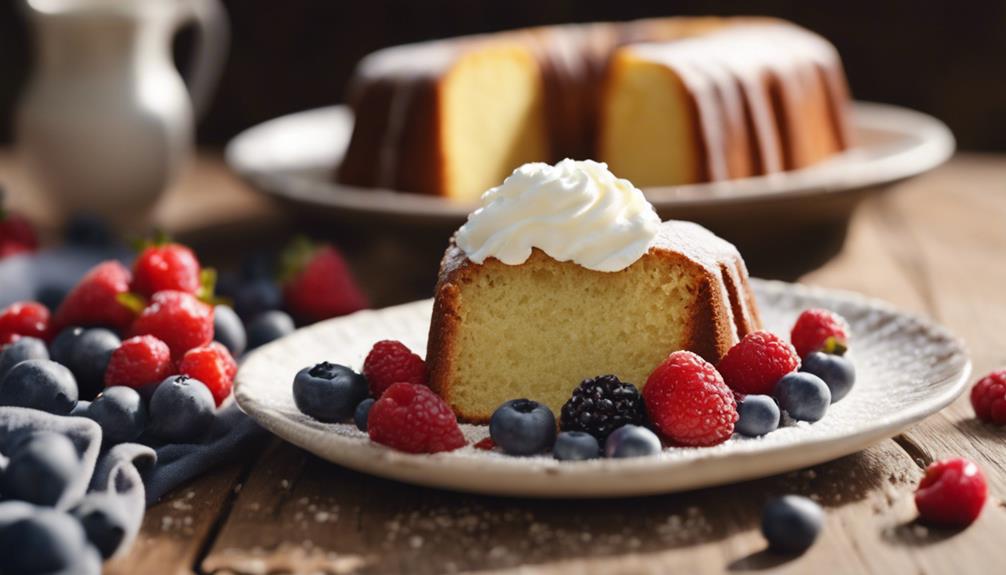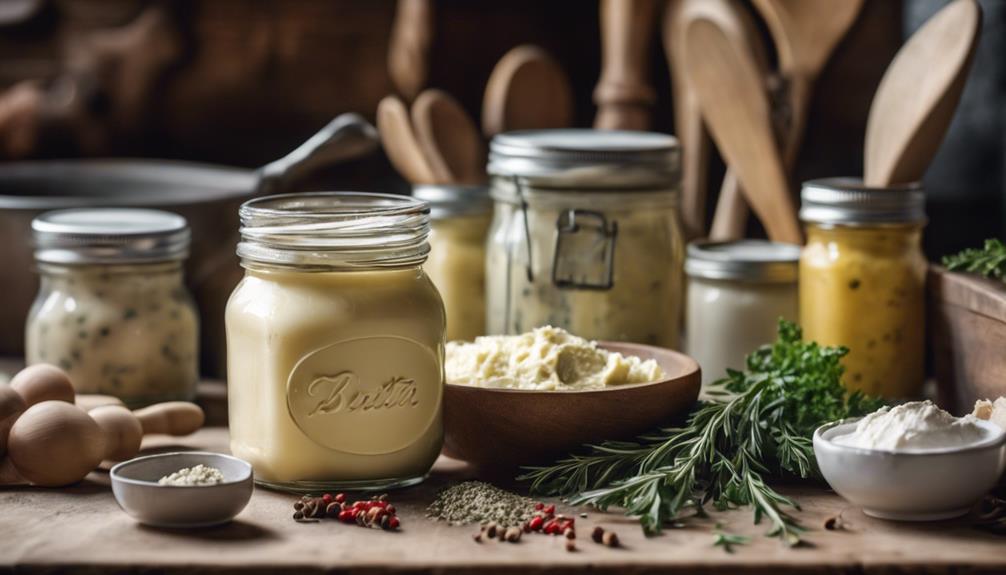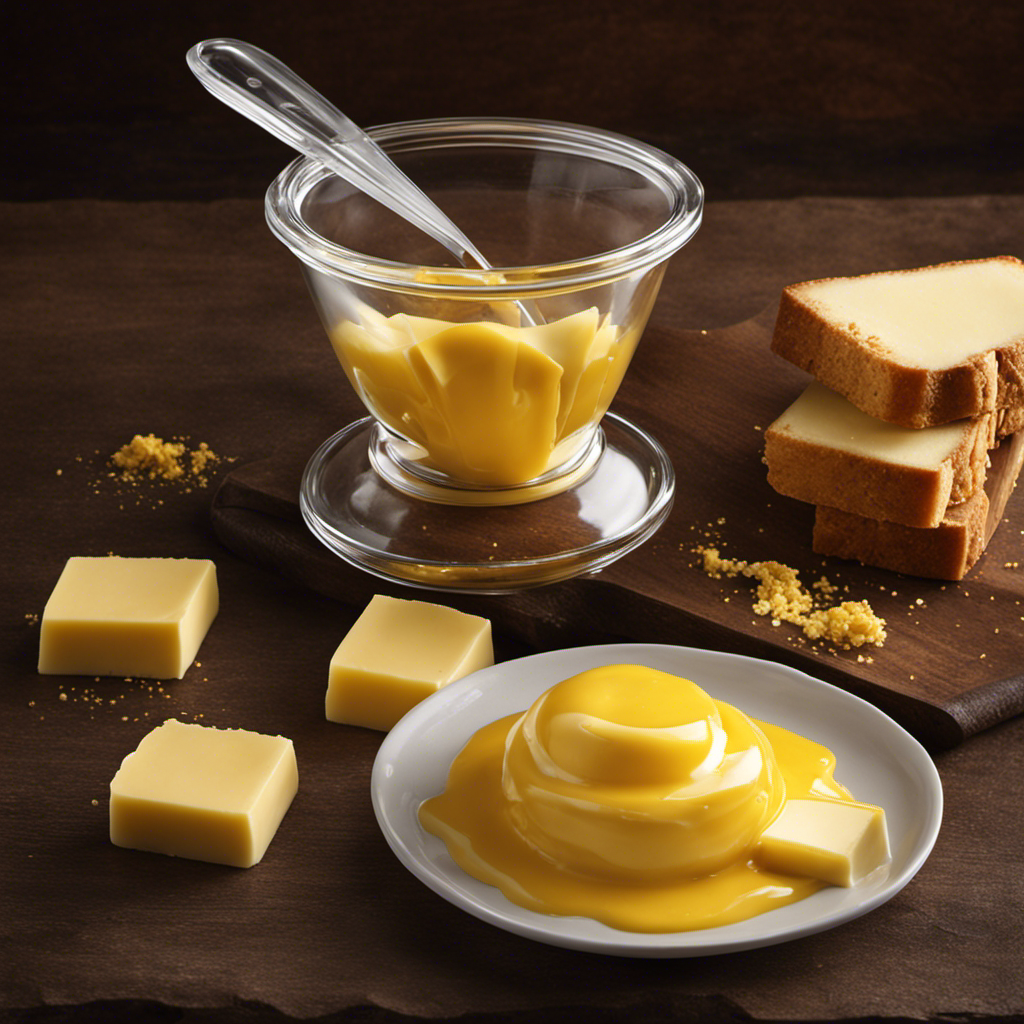Treat yourself to a rich, velvety butter pound cake that will leave you craving more. This recipe promises a delightful sweetness and comforting buttery flavor that's simply irresistible. With a luxurious mouthfeel and moist texture, it's perfect for any occasion. Enhance with glaze, fruit, or whipped cream for added delight. Experiencing the timeless joy this pound cake brings is a must. Learn how to make the perfect pound cake by creaming butter until fluffy and adding eggs one at a time. Keep exploring for tips, variations, and interactive experiences to elevate your baking skills and creativity.
Key Takeaways
- Cream butter and sugar for a fluffy texture.
- Incorporate eggs one at a time for a well-emulsified batter.
- Slowly add dry ingredients to prevent overmixing.
- Enhance with vanilla extract for rich flavor.
- Bake at the correct temperature for perfect results.
Vanilla Pound Cake Features
Indulge in the delightful sweetness and velvety texture of vanilla pound cake. This classic cake boasts a buttery flavor that's both comforting and satisfying. The velvety softness of the cake provides a luxurious mouthfeel that will have you coming back for more. Vanilla pound cake is considered one of the best in its category due to its rich taste and versatility. Despite its humble ingredients, this cake is a crowd-pleaser and a go-to dessert for many occasions.
The comforting aroma of vanilla permeates the air as the cake bakes to golden perfection. Its simple yet elegant taste profile makes it a favorite among bakers and dessert enthusiasts alike. Whether enjoyed plain or with a decadent topping, vanilla pound cake never fails to impress. Its flavor deepens over time, making it even more irresistible the day after baking.
Treat yourself to a slice of this classic delight and experience the timeless joy it brings.
Pound Cake Ingredients and Preparation
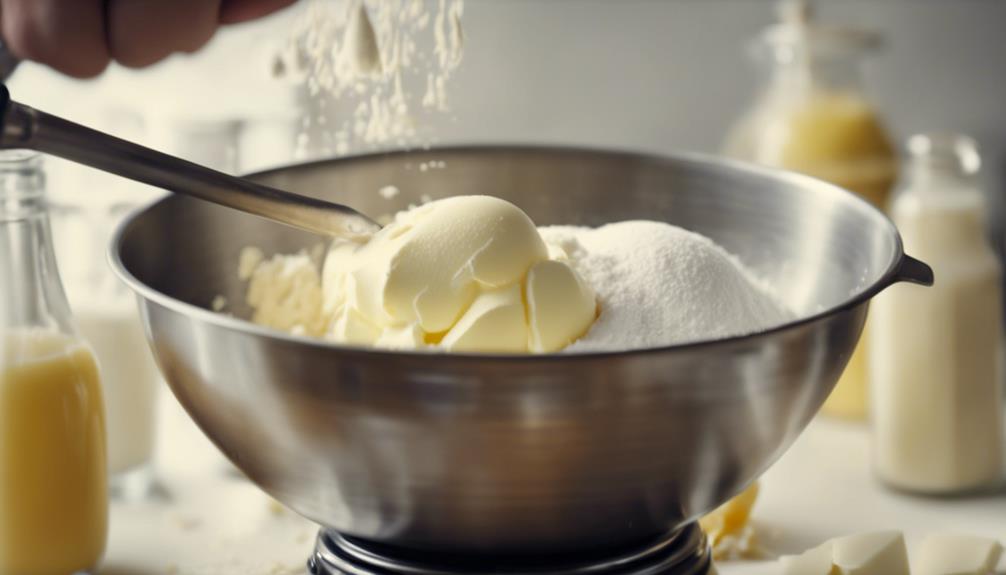
You need to gather flour, butter, sugar, eggs, vanilla, milk, and baking powder for your pound cake.
Start by creaming the butter and sugar to create a light and fluffy mixture.
Alternate between adding the dry ingredients and milk to achieve a smooth batter for your cake.
Pound Cake Ingredients
Pound cake ingredients typically consist of flour, butter, sugar, eggs, vanilla, milk, and baking powder. In a classic pound cake recipe, the key is in the name itself, as it was traditionally made with one pound each of butter, sugar, eggs, and flour. This simplicity highlights the rich and buttery flavor pound cake is known for. The addition of vanilla enhances the aroma, while baking powder provides the cake a slight lift, creating a delicate texture.
Creaming the butter and sugar together is a fundamental step in preparing pound cake. This process incorporates air into the mixture, leading to a light and fluffy cake. Alternating the addition of dry ingredients like flour and baking powder with milk guarantees a well-balanced batter, resulting in a moist and tender pound cake.
These carefully selected ingredients work in harmony to create a delightful treat that's loved by many.
Preparation Steps
To create a delectable butter pound cake, begin by creaming softened butter until smooth and free of lumps before gradually adding sugar. Next, incorporate eggs one at a time into the butter and sugar mixture, ensuring each egg is well combined before adding the next. Then, alternate adding dry ingredients like flour and baking powder with milk to the batter, mixing until just combined. Here is a simple guide to help you prepare the perfect butter pound cake:
| Preparation Steps |
|---|
| 1. Cream butter |
| 2. Incorporate eggs |
| 3. Alternate dry ingredients |
Once the batter is ready, pour it into a well-greased bundt pan and bake the pound cake until a toothpick comes out clean when inserted into the center. After baking, allow the pound cake to cool before slicing and serving to enjoy the best texture and flavor.
Baking and Cooling Instructions
For best outcomes, make certain that the butter pound cake batter is evenly distributed in the well-greased bundt pan before placing it in the oven to bake. Start by creaming the butter until soft and lumps free, then gradually add sugar while mixing thoroughly.
Incorporate eggs one at a time into the mixture, making sure each is well combined before adding the next. Alternate adding the dry ingredients and milk to the batter, beginning and ending with the dry ingredients for a well-balanced texture. Once the batter is ready, pour it into a well-greased and floured bundt pan to bake evenly.
After baking, allow the pound cake to cool in the pan for about 10 minutes to set. Then, transfer it carefully onto a cooling rack to cool completely. This cooling process helps the cake firm up and develop its full flavor.
Following these baking and cooling instructions will guarantee a delicious butter pound cake that you'll crave time and time again.
Serving and Storage Tips
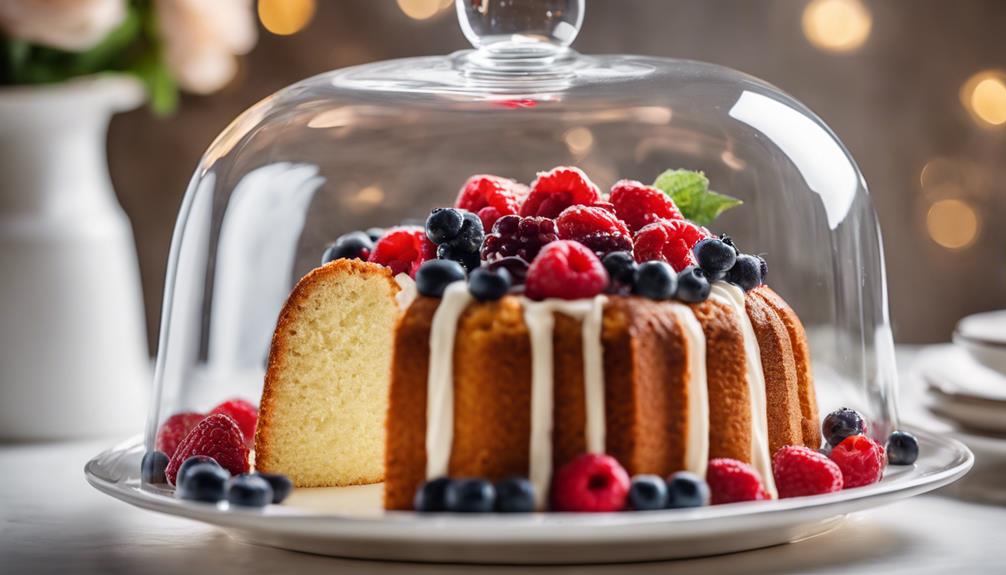
Consider enhancing your pound cake by serving it with various accompaniments and storing it properly to maintain its freshness. When serving your best pound cake, try topping it with glaze, powdered sugar, fresh fruit, or whipped cream to elevate its flavors and presentation. For a delightful twist, toast a slice of pound cake with butter or enjoy it as a dessert for a satisfying treat.
To secure your pound cake stays fresh, store it tightly covered in a cool, dry place for up to 4 days. If you need to store it for longer, freezing is an option. When freezing, wrap the pound cake well and thaw it properly to retain its delicious taste and texture. Remember, the flavor of pound cake matures over time, so it's often best enjoyed a day after baking.
| Pound Cake Flavors | Pound Cake Toppings | Pound Cake Presentation |
|---|---|---|
| Vanilla | Glaze | Fresh Fruit |
| Lemon | Powdered Sugar | Whipped Cream |
| Almond | Chocolate Drizzle | Nuts |
Neapolitan Pound Cake Variation

To create Neapolitan Pound Cake, you'll enjoy distinct layers of chocolate, vanilla, and strawberry flavors in one delightful treat.
By dividing the batter and adding cocoa powder or strawberries, you'll achieve the signature look and taste of Neapolitan.
Baking this variation as directed will result in a modern twist on the traditional pound cake, offering a fun and tasty way to enjoy different flavors in a single dessert.
Flavorful Neapolitan Layers
Explore the delightful combination of chocolate, vanilla, and strawberry flavors in the Neapolitan Pound Cake variation, adding a playful twist to your traditional pound cake recipe. This variation layers the distinct flavors beautifully in a loaf pan with separators, creating a visually appealing and delicious treat. Below is a table outlining how the Neapolitan layers come together:
| Layer | Flavor |
|---|---|
| Bottom | Chocolate |
| Middle | Vanilla |
| Top | Strawberry |
| Repeat | Chocolate |
| Top | Vanilla |
This method of dividing the batter and layering it not only enhances the taste but also provides a colorful presentation. The Neapolitan Pound Cake variation is a fun way to enjoy the classic pound cake with a twist of flavors. Stay tuned to learn how to master the layering and baking technique for this delightful treat.
Layering and Baking Technique
Let's now get into the process of layering and baking the Neapolitan Pound Cake variation to achieve those delightful chocolate, vanilla, and strawberry flavors in each bite.
Here's how you can create this unique twist on the traditional pound cake:
- Prepare the Layers: Start by making the base vanilla pound cake batter. Divide the batter into three portions. Flavor one portion with cocoa powder for the chocolate layer and another with fresh strawberries for the strawberry layer.
- Layering in the Loaf Pan: Place separators in a loaf pan to divide it into three sections. Pour the chocolate, vanilla, and strawberry batters into their respective sections, creating distinct layers in the pan.
- Baking Technique: Follow the baking instructions as per the recipe. The Neapolitan Pound Cake will bake into a visually stunning dessert with layers of chocolate, vanilla, and strawberry flavors melded together in each slice.
With this layering and baking technique, you'll enjoy a delicious Neapolitan Pound Cake that's sure to impress with its delightful flavors and beautiful presentation.
Recipe Sharing and User Interaction
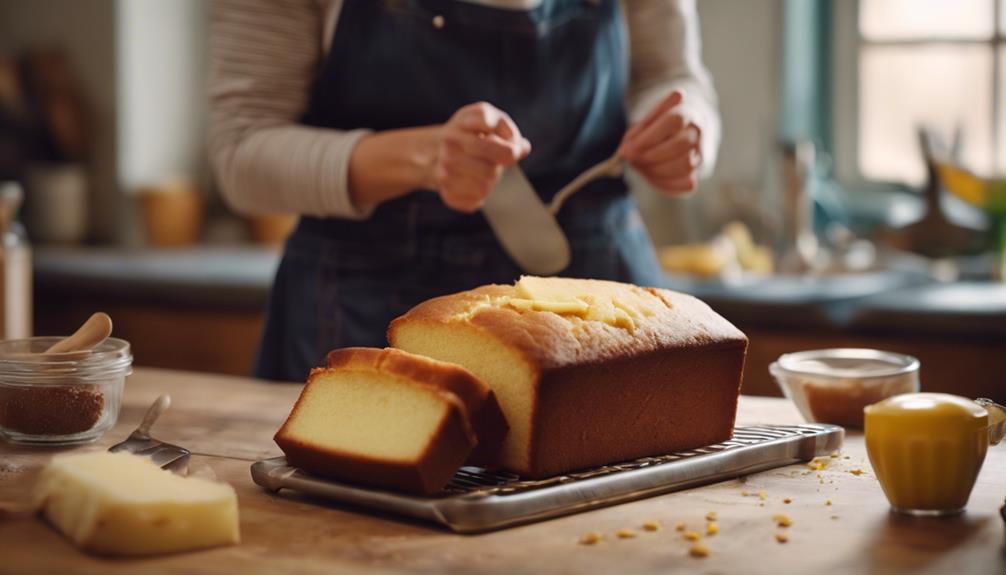
Enhance your baking experience by engaging with the pound cake recipe community through sharing tips, modifications, and serving suggestions. User interactions play an essential role in refining the pound cake recipes. By providing feedback, rating the recipes, and leaving comments, you contribute to a vibrant recipe community.
Don't forget to share your favorite pound cake variations on social media platforms to inspire others and expand the reach of these delightful recipes.
Moreover, the website's tagging system allows for easy categorization of recipes, making it simpler for users to find specific pound cake variations. Whether you prefer a classic butter pound cake or want to experiment with different ingredients, tagging recipes ensures that you can locate them effortlessly.
Additionally, consider exploring modifications suggested by other users to customize the recipe to your liking. By actively participating in the recipe community, you not only benefit from shared knowledge but also contribute to a collaborative baking environment.
Why This Is The Perfect Pound Cake Recipe
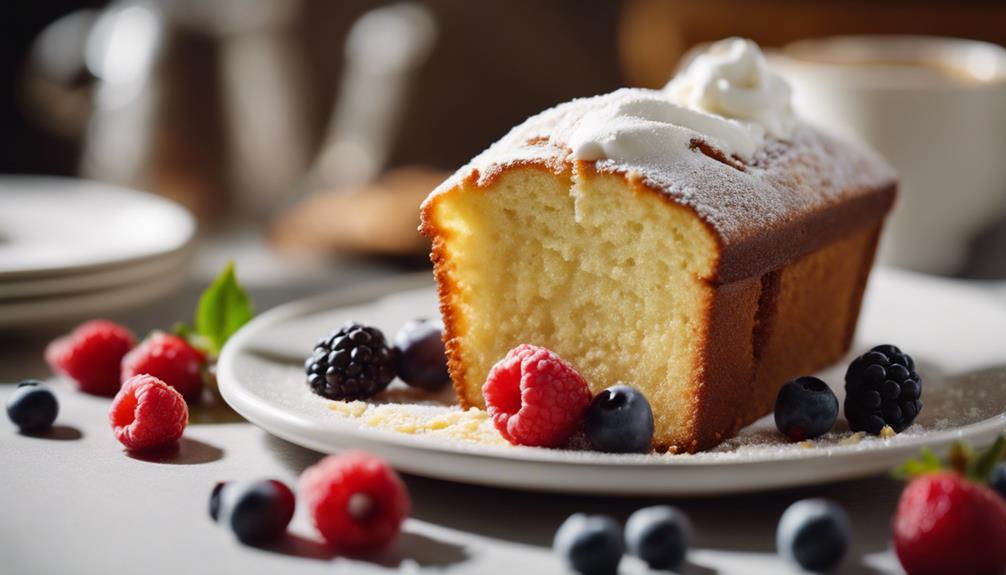
To understand why this pound cake recipe stands out as the perfect choice, consider its irresistible blend of buttery flavor and moist texture. Here's why this pound cake is a standout option:
- Moist Pound Cake: This recipe guarantees your pound cake remains moist and decadent, avoiding the dryness that can sometimes plague other cakes.
- One-Bowl Recipe: With just six simple ingredients and a one-bowl preparation method, this pound cake isn't only delicious but also incredibly easy to make, saving you time and effort in the kitchen.
- Crowd-Pleaser with Variety of Toppings: Whether you choose to enjoy it plain or dress it up with toppings like glaze, powdered sugar, whipped cream, or fresh fruit, this pound cake is a versatile treat that can cater to diverse preferences.
The tight crumb, velvety texture, and dense nature of this cake make it a quick and easy recipe that never fails to impress. Perfect for any occasion, this pound cake is bound to be a hit with everyone who tries it.
Pound Cake Ingredients Overview
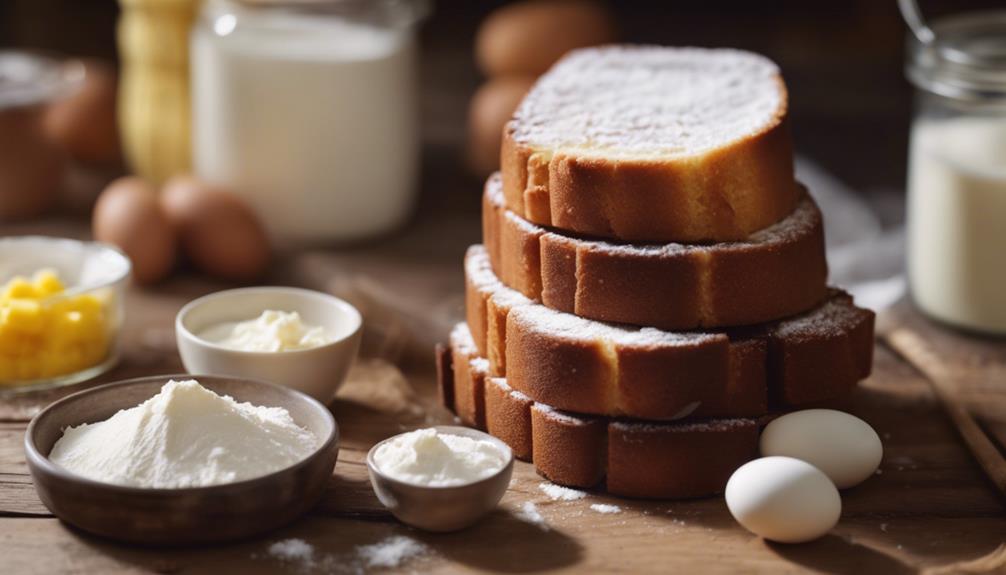
Explore the essential ingredients that make up a classic pound cake recipe. Pound cake is a delightful treat that typically includes butter, sugar, eggs, flour, and vanilla extract. These core components form the foundation of a rich and decadent dessert.
While the traditional pound cake recipe follows a ratio of equal parts butter, sugar, eggs, and flour, modern variations may deviate from this strict proportion. To achieve a lighter texture, some recipes incorporate leavening agents like baking powder. Additionally, pound cakes often feature dairy elements such as milk, sour cream, or buttermilk to enhance moisture and richness.
For added flair, flavor variations can be introduced through ingredients like citrus zest, spices, nuts, or chocolate, offering a creative twist on the classic pound cake recipe. By combining these key components in various ways, you can create a pound cake that suits your taste preferences and culinary creativity.
How To Make Pound Cake
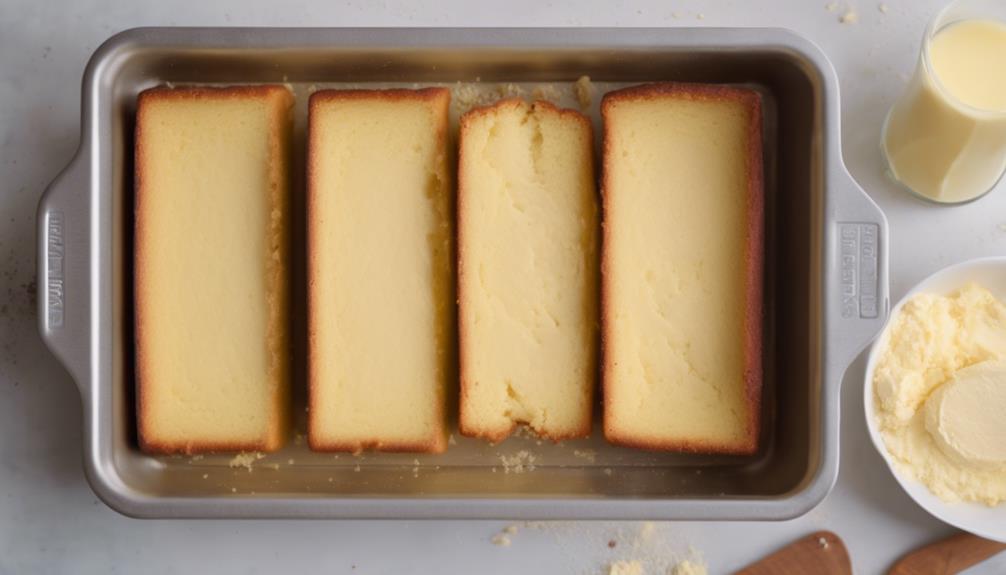
To make a pound cake, start by creaming softened butter until it's light and fluffy before adding sugar for the perfect texture.
Here's a simple guide to help you achieve that delectable butter pound cake:
- Incorporate Eggs Thoughtfully: Add eggs one at a time into the butter-sugar mixture to guarantee a well-emulsified batter that contributes to the cake's richness.
- Handle Dry Ingredients with Care: Slowly add dry ingredients like flour and baking powder to prevent overmixing, which can lead to a tough texture. This method helps preserve a tender crumb in your pound cake.
- Bake to Perfection: Flavor the batter with vanilla extract to enhance the taste, then pour it into a well-greased and floured pan. Bake at the correct temperature for even baking, resulting in a golden crust that encases a tender, moist interior.
Frequently Asked Questions
What Is the Difference Between a Butter Cake and a Pound Cake?
When comparing a butter cake to a pound cake, remember that butter cakes often include leavening agents for a softer texture and more moisture. Pound cakes, on the other hand, focus on simplicity and a denser, velvety feel.
Is It Better to Bake Pound Cake at 325 or 350?
For a moist and evenly baked pound cake, baking at 325°F is recommended. This lower temperature helps prevent over-browning and guarantees a tender crumb. It's important to achieve that perfect balance between texture and flavor.
What Does Cream of Tartar Do in Pound Cake?
In your pound cake, cream of tartar stabilizes and adds volume to beaten egg whites. It reacts with baking soda to create carbon dioxide gas for leavening. This ingredient prevents sugar crystallization, improves texture, and enhances flavor by balancing sweetness and acidity.
How Many Eggs Is a Pound of Eggs?
To make a pound of eggs, you'd typically use about 8 large eggs or 9 medium-sized ones. Remember, it's about the weight, not just the number of eggs. So, choose wisely based on your recipe needs!
Conclusion
Now that you've mastered the art of making this delicious butter pound cake, you'll be feeling like a baking rockstar!
So go ahead, whip up another batch and indulge in this sweet treat that will have you coming back for more.
This pound cake recipe is like a warm hug on a rainy day – comforting, satisfying, and oh so delicious!
